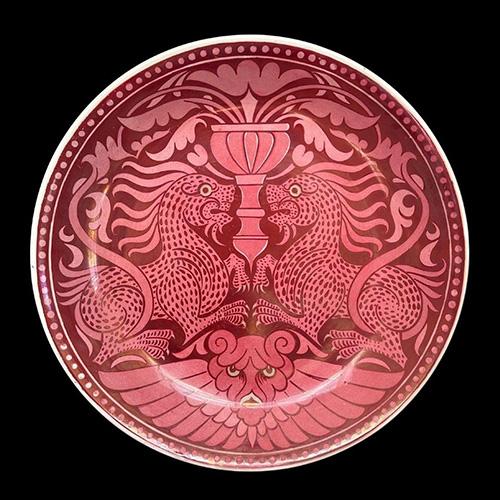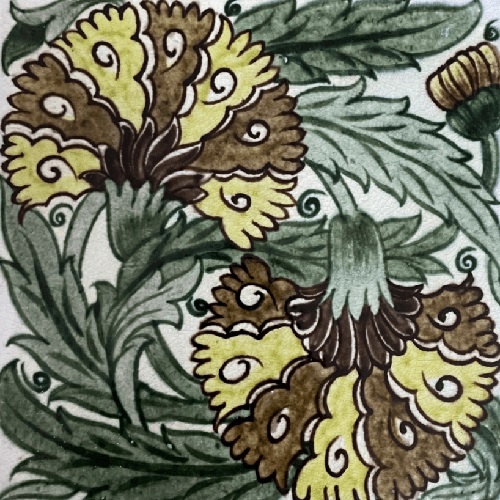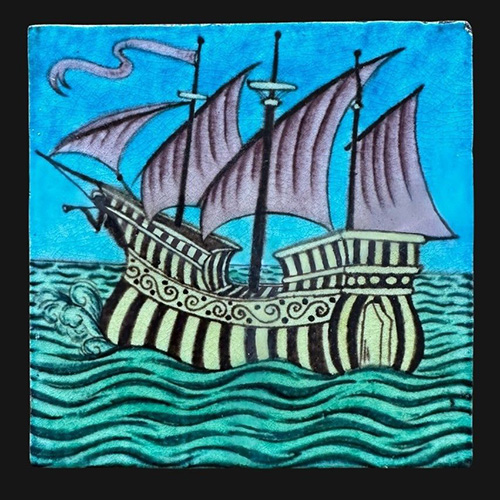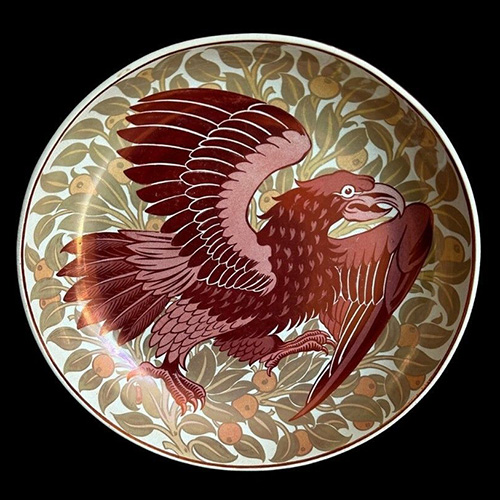

One of the cornerstones of early British Art Pottery, William De Morgan’s beguiling creations are amongst the finest of the Arts and Crafts movement. A prolific producer of household tiles, his iconic designs became an essential and often imitated element of mid-Victorian interior design.
Born in London’s fashionable Bloomsbury district in 1839, William was the eldest of seven children born to Sophia and Augustus De Morgan. His mother Sophia was an activist for women’s suffrage and played a role in the establishment of Bedford College, London, the UK’s first higher education college for Women.
His father, Augustus, was one of the leading mathematicians of his time, and would instil a passion for geometry and symmetry in William which can be seen throughout his later designs. With such well-educated and liberal parents, it is no surprise that young De Morgan enjoyed a comfortable childhood and was encouraged to pursue his interests in the visual arts.
After taking classes at Francis Stephen Cary’s academy in Bloomsbury, William earned a place at the Royal Academy of Arts, where he began studying in 1859. However, after a meeting with William Morris in 1863, De Morgan chose to leave the course midway through his studies. Instead, he opted to pursue a career as a designer for the former’s recently established company Morris, Marshall, Faulkner & Co.
 De Morgan’s initial work for the company was largely in the field of stained glass although his fascination for innovation and methods of production would soon trigger a switch to ceramics. While experimenting with silver oxide in a glass kiln, William noted that when starved of oxygen an opaque, iridescent finish was left on the glass, similar to the lost technique of lustreware.
De Morgan’s initial work for the company was largely in the field of stained glass although his fascination for innovation and methods of production would soon trigger a switch to ceramics. While experimenting with silver oxide in a glass kiln, William noted that when starved of oxygen an opaque, iridescent finish was left on the glass, similar to the lost technique of lustreware.
He became so obsessed with the need to perfect the technology that De Morgan inadvertently set fire to the roof of his home in Fitzroy Square, whilst using the hearth as a makeshift kiln. This led to William taking premises at Cheyne Row, Chelsea, where his output swiftly changed focus from stained glass to ceramics production.
Ironically, De Morgan never learned to throw his own clay but would buy in blank tiles, plates, and chargers from the likes of Wedgwood, Mintons and Poole Pottery to satisfy his prolific output. Heavily influenced by Medieval designs and Iznik pottery of the Ottoman Empire, Williams vibrant depictions of flora and fauna, majestic ships and mythical creatures proved immensely popular.
With easily cleaned surfaces, tiles revolutionised Victorian domestic tastes and could be found in kitchens, bathrooms, fireplaces and even furniture designs. Perhaps the most ingenious element of De Morgan’s early tile designs is the geometric versatility which enabled the tiles to be installed both vertically and horizontally with equal impact.
 To meet demand, William took on more staff, including decorators Charles and Fred Passenger, brothers who would play an influential role in the evolution of the business. He also relocated to larger premises at Merton Abbey, South London, finally enabling the factory to throw and fire their own pots. In fact, at its height, De Morgan had a workforce of up to 40 employees at the Merton studio.
To meet demand, William took on more staff, including decorators Charles and Fred Passenger, brothers who would play an influential role in the evolution of the business. He also relocated to larger premises at Merton Abbey, South London, finally enabling the factory to throw and fire their own pots. In fact, at its height, De Morgan had a workforce of up to 40 employees at the Merton studio.
Notable patrons of the time included the British Royal Family and the Czar of Russia, who ordered several commissions. The Peninsular and Oriental Steam Navigation Company (P & O) even commissioned De Morgan to design a range of tiles for installation across 12 of their luxury liners.
Despite the phenomenal output of tiles from this period, it was during his time at Merton Abbey that William was able to produce some of his finest art pottery. Having refined and perfected his mastery of lustreware and glazes, De Morgan focussed his attention on transferring his trademark designs from 2D tiles to three dimensional vessels and chargers with remarkable affect.
In the early 1880s, William’s health began to fail and after marrying the pre-Raphaelite painter Evelyn De Morgan in 1887, the couple would spend half the year in Florence to avoid the London winter. To shorten the journey from his central London home, De Morgan also relocated the company once more to Sands End, Fulham in 1888.
 Despite the unquestionable quality of his work and the demand from notable patrons worldwide, De Morgan & Co. struggled to make a meaningful profit throughout the 1890s and early 1900s. Increasingly, William handed the day to day running of the business over to the Passenger Brothers before stepping away altogether in 1904.
Despite the unquestionable quality of his work and the demand from notable patrons worldwide, De Morgan & Co. struggled to make a meaningful profit throughout the 1890s and early 1900s. Increasingly, William handed the day to day running of the business over to the Passenger Brothers before stepping away altogether in 1904.
Having dedicated his life to the creation of his art, De Morgan slipped into a deep depression, but happily his story does not end there. Encouraged by wife Evelyn, William began writing, and published his first novel, ‘Joseph Vance an Ill-Written Autobiography’ in 1906.
A semi-autobiographical work, the book became an international hit, and was the first of seven novels De Morgan would release. In a supreme irony, his writing would not only make William’s fortune but bring him more contemporary acclaim than he had achieved in a lifetime in ceramics. Thankfully, more than a century after his passing in 1917, William De Morgan’s brilliant ceramics once again enjoy the worldwide appreciation they so richly deserve.
Click here to view a selection of De Morgan pieces currently available from BADA members.

